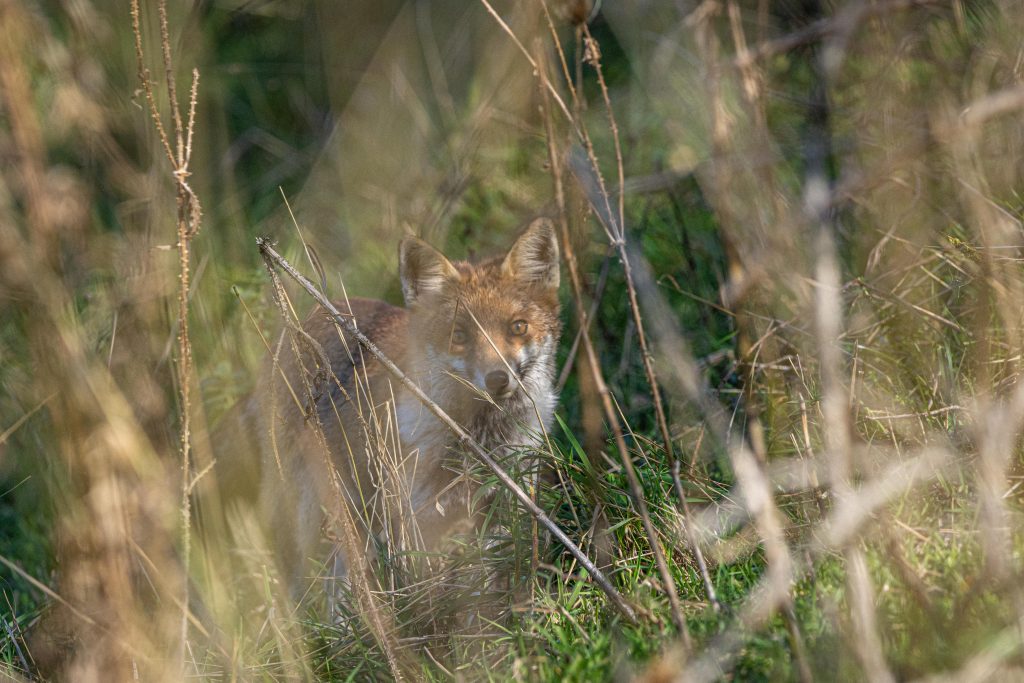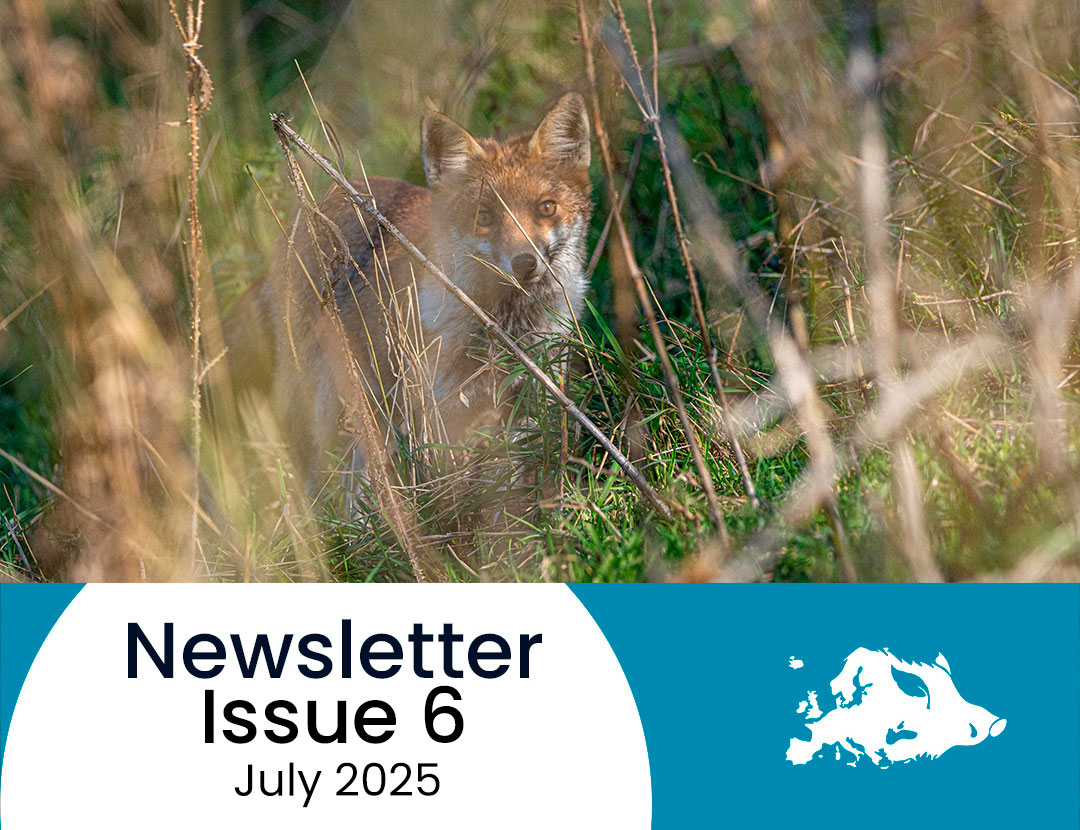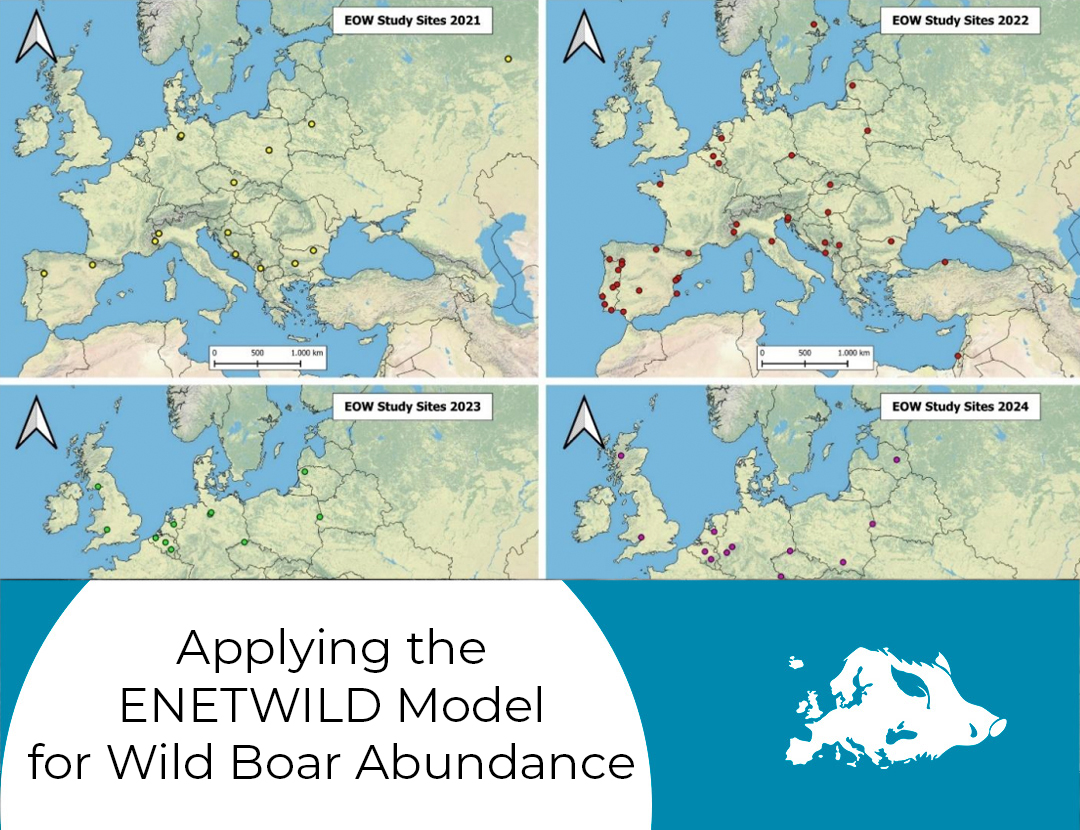Welcome to the ENETWILD Newsletter!
ENETWILD is an international network of wildlife professionals focused on integrating wildlife management with pathogens’ surveillance and management. The project is funded by EFSA.
In this newsletter you will stay in the loop on the latest publications and updates in the wildlife world, you will have access to event information and will get to know more about the people involved in the project.

Latest related publications
Epidemiological analysis of African swine fever in the European Union during 2024
https://doi.org/10.2903/j.efsa.2025.9436
Contact between soft tick vectors of African swine fever virus and invasive wild pigs in the southeastern USA
https://doi.org/10.1186/s13071-025-06811-1
From field to database: a review of practices of hunting bag data collection, obstacles and solutions across European countries
https://zenodo.org/records/16281457
In case you missed previous publications
Highly pathogenic avian influenza in wild mammals: critical appraisal of spill-over events and of strategies for prevention, surveillance and preparedness
https://zenodo.org/records/14002535– ENETWILD Consortium
Machine learning algorithms for the evaluation of risk by tick-borne pathogens in Europe
https://www.tandfonline.com/doi/full/10.1080/07853890.2024.2405074
Piece of news available here
Pharmaceuticals in avian scavengers and other birds of prey: A toxicological perspective to improve risk assessments
https://www.sciencedirect.com/science/article/abs/pii/S004896972404573X?via%3Dihub
Piece of news available here
Effectiveness of methods for controlling wild boar movements
https://zenodo.org/records/12705762 – ENETWILD Consortium
Knowledge, perception, and awareness of society regarding (over)abundance of wild ungulate populations
https://ecologyandsociety.org/vol29/iss1/art24
Piece of news available here
Wild boar as sentinel of Crimean-Congo hemorrhagic fever in Spain and Portugal
https://www.sciencedirect.com/science/article/pii/S1877959X23001620?via%3Dihub
Piece of news available here
Effect of Myxoma Virus Species Jump on Iberian Hare Populations https://wwwnc.cdc.gov/eid/article/30/6/23-1280_article
Piece of news available here
Latest related publications
Highlights from the Report:
“Highly pathogenic Avian influenza in wild mammals: critical appraisal of spill-over events and of strategies for prevention, surveillance and preparedness”

The risk of HPAI spreading to mammals is greatest at “hot-spots” where large numbers of birds gather, such as migration and breeding grounds. Mammals sharing these habitats are at particular risk.
A mammal’s susceptibility to the virus is strongly influenced by intrinsic and extinsic factors such as species, age and diet. Predatory and scavenging habits are significant drivers of transmission.
The fact that 44 out of 51 mammal species affected since 2016 are carnivores provides strong evidence that dietary habits are a primary transmission factor.
In captive settings like zoos and wildlife farms, spillover events are primarily caused by a combination of inadequate biosecurity practices, unsafe feeding practices, environmental contamination, and proximity to HPAI outbreaks.
For early detection and a full understanding of an outbreak, surveillance programs must be comprehensive, including both passive monitoring of the sick and dead and active tracking of survivors.
Prevention requires a combination of enhanced surveillance and strict biosecurity, involving strategies like segregating species, managing food sources, and designing landscapes to reduce contact between at-risk animals.
Managing HPAI effectively depends on key communication strategies, such as building international expert networks, integrating communication into national policies, and using a multi-disciplinary approach to foster behavioral change.
ENETWILD recently participated in a key Regional Meeting with 13 French Federations from Southern France, hosted in Carcassonne


Carcassonne, France. June 30th
Ezio Ferroglio from UNITO, as current chair of the Consortium, presented the ENETWILD project and its various activities. Ferran Jori from CIRAD presented the protocol of the European Observatory of Wildlife, which is being deployed in the French Eastern Pyrenees. Hugues Frank, Director FDC35 Ille & Vilaine, shared his experience with ENETWILD in the process of density estimation in Ille et Vilaine. Additionally, there was a highly interesting presentation on the application of the REM method in the Western Pyrenees (Department of Ariège) to estimate Pyrenean chamois densities based on the EOW protocol.
ENETWILD’s participation in this meeting was greatly appreciated. A total of 26 people attended in person, with at least 10 more joining online.
Interview

Relax and enjoy this interview with Massimo Scandura, Full professor of University of Sassari, Italy
Could you start telling us a bit about your role in the project?
As member of the University of Sassari I am engaged in the project since the start of the first edition, dating 2017. At that time, I was involved in collating and harmonising wildlife data from the geographic region assigned to UNISS, i.e. south-eastern Europe. Then, in the last years, I contributed to the organization of the European Observatory of Wildlife (EOW). In the current edition of the project (ENETWILD2.0) I am coordinating the work package dealing with “data generation”, that is specifically addressed through the activity of the EOW.
Why does the project ENETWILD motivate you?
From the very beginning, the participation in this project was very stimulating. I was frequently struggling with the problems arising from a lack of large-scale data harmonisation and ENETWILD was the occasion to actively contribute to a solution.
I am perfectly aware that sometimes this is already a challenge at a national scale (and my country is an example of this), so let alone at a trans-national one!
However, though I am convinced that no magic wand exists for it, I do believe that great improvements have been made in the last 20 years in the attitude to collaborate (see, for example, citizen science initiatives) and extraordinary new technologies have been introduced that simplify data collection, analysis and sharing. And this makes me optimist.
“I do believe that great improvements have been made in the last 20 years in the attitude to collaborate and extraordinary”
Why does the project ENETWILD motivate you?
ENETWILD is a rare example of applicative project committed to providing concrete solutions and tools to national and international decision-makers dealing with wildlife management. Specifically, providing harmonised abundance data to be used for spatial modelling at European scale is a great achievement. But even the production of guidelines and the development of data standards and protocols is a valuable result. The main application is connected to the EFSA’s mandate, i.e. feeding models of risk assessment for the spread of pathogens, dangerous for domestic animals and humans.
The Observatory is based on a decentralized network of independent observation points that follow harmonized methods. How do you balance the need for scientific standardization with the independence and diversity of the local partners, ensuring both data comparability and local ownership of the monitoring efforts?
This is actually the key to the success of the initiative. Not only local participants but also the ecological contexts where they operate are very different. But this diversity is also the force of the project. We offer straightforward reference protocols (and assistance in the form of training, tutorials, helpdesk), which can be implemented in almost any condition with moderate effort and cost. Therefore, participants do not have to invent anything. They can simply follow our guidelines and use our IT tools to obtain reliable estimates that can be compared with dozens of other sites across Europe. And in so doing they maintain ownership of their raw data and have the opportunity to be involved in collaborative studies aimed at advancing scientific knowledge. It’s therefore a clearly win-win strategy.
One of the ambitious goals of the Observatory seems to be creating a self-sustaining legacy: partners progressively learn to apply the protocols autonomously and find value in the data for their own work, reducing reliance on central support. What strategies are you putting in place to ensure this long-term sustainability of the network beyond the ENETWILD project?
Well noted! This is a key point in measuring the ultimate success of our initiative.
As mentioned, the Observatory’s approach is collaborative, and the benefits are for all participants. The trick is to make these benefits long-lasting. In the case of the application of camera trapping to estimate species density, for example, we can’t neglect the equipment costs and the considerable effort required for fieldwork and sequence annotation in Agouti (our dedicated IT tool). What is crucial is that the balance between this investment and obtaining multispecies abundance data, replicable in space and time and comparable with open access data gathered in a similar way at other sites, is in favour of the latter.
So, our strategy is to maximize the benefit by reducing the effort through a simplification of manual steps and the use of AI. Of course, all this assumes that participants have a strong interest in obtaining this information; but if they join the EOW usually they do, for sanitary reasons, to manage hunting or human-wildlife conflicts, or simply to monitor biodiversity.
In addition, the protocols and the IT tools developed so far, as well as the training sessions (visible in Youtube) and the final estimates (accessible in Zenodo) are already a legacy of the project; everyone can use them beyond their EOW membership.
“Our strategy is to maximize the benefit by reducing the effort through a simplification of manual steps and the use of AI”
In practical terms, what makes the Observatory attractive to new partners in the long run? Beyond initial support like training and tools, how do you ensure that the protocols and approaches remain relevant, useful, and integrated into the routine activities of those managing wildlife monitoring local?
Since 2021 the EOW has progressively enlarged, thanks to the spontaneous participation of >40 professionals active in different countries and to the increase in the number of sites monitored by each partner.
Joining the Observatory means not simply implementing our protocols and tools, but being part of a community, embracing a collaborative approach to gather and share valuable data that can be used for wildlife management, biodiversity conservation and disease surveillance, but also for scientific research. Many partners are interested in the scientific output, that is in using the data collected to answer scientific questions on species’ ecology or population dynamics, or are motivated by the continuous refinement of protocols to increase the reliability of estimates. We are confident that this community will be active beyond ENETWILD. Some others join the EOW for very pragmatic reasons (i.e. they need population data, for instance in the case of ASF prevention). The real challenge is to expand this component, advertising the advantages offered by the use of EOW protocols and IT tools in routine activities. Only a good promotion among key stakeholders (ministries, national agencies, parks, hunting federations) will allow this to be achieved. We need to invest even more in this direction.
What would you like ENTEWILD and the EOW to accomplish in the end?
Coming back to your question on my motivation in the project, I would really like the project to contribute to establishing a European framework for wildlife management, offering harmonised data and science-based solutions to manage present and future challenges (diseases, climate changes, alien species, among others) from a global, transnational perspective. In this sense, the main goal of the EOW will be the establishment of a self-sustainable network of observation stations that adopt common protocols and publicly share the resulting estimates. This will represent a valuable source of information for national and international decision-makers (e.g., European Commission).
What would you like ENTEWILD and the EOW to accomplish in the end?
Thanks for giving me the opportunity to clarify the role of the Observatory within the ENETWILD project. The campaign 2025 has just started but it’s still possible to join.
I invite readers to visit our updated website (www.wildlifeobservatory.org), where they can find a map of EOW sites, protocols and supporting material, published reports and direct links to our IT tools.
Anyone can feel free to contact us (eow@uniss.it) for any questions.




